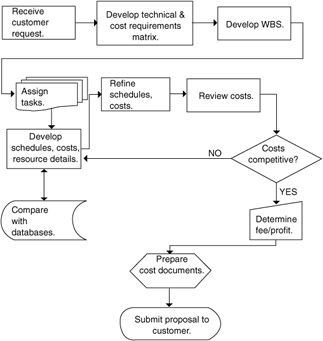Validating the Schedule and Budget Estimates
|
Schedules and budgets are estimated for individual projects using the tools we discussed earlier—the WBS, network analysis, and Gantt charts. But once these schedules and budgets are completed for each individual project, they have to be evaluated and validated in the context of the company's total program and portfolio activities, that is, each project is evaluated against all other projects across the company. Otherwise, there will be no sense of whether the company can manage all the projects with available resources or if the schedules can be met within the construct of resources allocated across multiple projects.
There should be at least two formal reviews for both the project's technical and cost approaches. The first review for the technical proposal (often called the blue team review) occurs fairly early in the process. The basic function of this review is to determine whether the customer's requirements are understood and the technical approach is viable. The second review, called the red team review, occurs near the end of the planning cycle and is a very thorough review of the proposed approach from the customer's perspective. This review addresses the customer's requirements, the technical approach, and, in short, whether all the requirements have been addressed. This review has to be accomplished late enough in the cycle that all the key elements of the plan are complete, but early enough to incorporate needed changes.
The first review for the cost detail is called the gold team review. This team looks at the approach, whether the costing team has considered all the customer requirements, and if the cost strategies are viable. The second review, the green team review, occurs approximately a week after the red team reviews the technical proposal. This timing is necessary in order to revise the costs if the red team uncovers omissions or other discrepancies in the technical approach.
Even when the costs have been reviewed and the green team agrees that the costs are comprehensive and accurate, the senior official responsible for the final cost document—or proposal, as the case may be—will want to review the costs, or at least the bottom line. The project manager and the costing person should be prepared to defend the cost figures and their rationale for them. The project manager should also be prepared to make a recommendation relative to how much profit to apply. Since profit is the only rate that is flexible, a smaller profit or even no profit can be used to reduce the overall price if the effort is a competitive bid, for example. The decision about how much or how little profit to use resides with the company president or a designated representative. However, the project manager should have an estimate of what the customer is willing to pay and what it will take to win the job. Thus, the amount of profit that keeps the price below the target price is the appropriate profit rate to apply to obtain the work. Exhibit 6-3 describes the schedule, cost, and resource estimating process.
Exhibit 6-3: Sample schedule and cost-estimating process.

Schedules and costs are intricately interwoven. They impact each other as one and then the other changes over time. But just as schedules and costs are intricately balanced, so are they both dependent upon how resources are allocated across the company's many projects.
|
EAN: 2147483647
Pages: 129
- ERP Systems Impact on Organizations
- The Effects of an Enterprise Resource Planning System (ERP) Implementation on Job Characteristics – A Study using the Hackman and Oldham Job Characteristics Model
- Context Management of ERP Processes in Virtual Communities
- Distributed Data Warehouse for Geo-spatial Services
- Data Mining for Business Process Reengineering